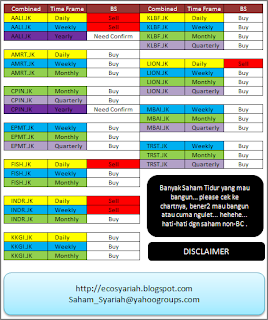Coba2 backtest Project Bargain Hunter nya mas Wisnu... hasilnya profit 4500.71% khusus backtest pd saham2 yg ada di Indeks JII. Performance sistem per bulan atau per tahun, seperti yg terlihat pd tabel berikut...
Tabel itu juga bisa dipakai untuk melihat pd bulan2 apa system ini berfungsi dgn maksimum speed dan pd bulan2 apa dia slowdown bahkan mogok...
Buat teman2 yg blm coba... saya sarankan untuk coba backtest Project Bargain Hunter ini, saya yakin anda akan banyak memperoleh pelajaran... saya sebutkan satu diantaranya berupa pertanyaan: apakah ada sistem dengan return positif pada bulan May 2010 ? Anda tidak akan memperoleh jawabannya jika tidak belajar backtest thdp beberapa sistem gacoan anda.
AFL nya mas Wisnu saya copas di bagian bawah.
Thanks again mas Wisnu.
//================================
| Modal | 75,000,000 | |||
| MaxPostSize | 4 | |||
| Period | 1-Jan-05 | 23-Dec-10 | 6thn | |
| Statistics | ||||
| All trades | Long trades | Short trades | ||
| Initial capital | 75000000 | 75000000 | 75000000 | |
| Ending capital | 3450530170 | 3450530170 | 75000000 | |
| Net Profit | 3375530170 | 3375530170 | 0 | |
| Net Profit % | 4500.71% | 4500.71% | 0.00% | |
| Exposure % | 52.48% | 52.48% | 0.00% | |
| Net Risk Adjusted Return % | 8576.59% | 8576.59% | N/A | |
| Annual Return % | 89.85% | 89.85% | 0.00% | |
| Risk Adjusted Return % | 171.22% | 171.22% | N/A | |
//======================
On Tue, Dec 21, 2010 at 12:57 PM, Wisnu Mobile <> wrote:
Ternyata Wiseman1 lumayan menguntungkan.
1. 20 years backtested. CAR: 82%! WB kalah tuw.. Problema nya ada di MaxSysDD: -52%! Saya belum pernah lihat trader senior yang mampu stomach this kind of drawdown. Kalau beginner malah sering lihat.. :) Bisa diperbaiki dengan better Exit.
2. Entry: BULLISH DIVERGENCE BAR, with DISCOUNT as a qualifier (gantinya Angulasi). Silahkan diganti dengan kondisi lain yang anda mau. Leave variable names intact, supaya bisa dipanggil.
3. Simple MM: 5 max open positions (optimization capable - untuk yang mau belajar optimasi), RSI based position score.
4. Exit, karena tidak ada inputan - mungkin entry nya sangat profitable barangkali, saya pakai REVERSE Divergence Bar... hehe... silahkan diganti kalau punya kode yang lebih baik.
5. Realtime Entry-Exit.
Snapshot and code, attached.
Hari ini sudah masuk pasar lagi... jadinya project ini kudu diselesaikan.. :) Silahkan dikembangkan sendiri-sendiri ya..
Salam.
Code:
_SECTION_BEGIN("Price");
SetChartOptions(0,
_N(Title = StrFormat("{{NAME}} - {{INTERVAL}} {{DATE}} Open %g, Hi %g, Lo %g, Close %g (%.1f%%) Vol " +WriteVal( V, 1.0 ) +" {{VALUES}}", O, H, L, C, SelectedValue( ROC( C, 1 )) ));
Plot( C, "Close", ParamColor("Color", colorBlack ), styleNoTitle | ParamStyle("Style") | GetPriceStyle() );
if( ParamToggle("Tooltip shows", "All Values|Only Prices" ) )
{
ToolTip=StrFormat("Open: %g\nHigh: %g\nLow: %g\nClose: %g (%.1f%%)\nVolume: "+NumToStr( V, 1 ), O, H, L, C, SelectedValue( ROC( C, 1 )));
}
_SECTION_END();
_SECTION_BEGIN("Trade System");
GfxSelectFont("Tahoma", 12, 400);
GfxDrawText("Wiseman1 - BETA", 4, 15, 350, 40);
SetFormulaName("Wiseman1 - BETA");
SetTradeDelays( 0, 0, 0, 0);
MaxOpenPos=Optimize("
SetOption("MaxOpenPositions", MaxOpenPos);
PositionSize=-100/MaxOpenPos;
PositionScore=100-RSI();
/*Wiseman1*/
DivBar=(L(H+L)/2); //DivBar
/*Angulation Replacement - take out and replace if you want, but keep the variables name intact.*/
PriceDisc=1-Param("PriceDisc (%)", 5, 0, 50, 5)/100;
DBQualifier1=(C<=Ref(C,-Param(
WS1DivBar=DivBar AND DBQualifier1;
DaySinceDivBar=BarsSince(
WS1BuyCond1=C>Ref(H,-
Buy=WS1BuyCond1;
BuyPrice=Ref(H,-
RevDivBar=(L>Ref(L,-1)) AND (C<(H+L)/2); // Reverse DivBar Exit
DaySinceRevDivBar=BarsSince(
WS1ExitCond1=C
Sell=WS1ExitCond1;
SellPrice=Ref(L,-
Buy=ExRem(Buy,WS1DivBar);
Sell=ExRem(Sell,RevDivBar);
Sell=ExRem(Sell,Buy);
PlotShapes(IIf(WS1DivBar,
PlotShapes(IIf(Buy,
PlotShapes(IIf(RevDivBar,
PlotShapes(IIf(Sell,
_SECTION_END();
_SECTION_BEGIN("Daily Explorer");
Filter=Buy OR Sell;
AddTextColumn( WriteIf(Buy, "Buy!",
WriteIf(Sell, "Sell!", "")), "Trade Signal", 1.0);
AddColumn(C, "Close", 1.0);
_SECTION_END();
//======================
Semoga bermanfaat.
Eco Syariah

















































